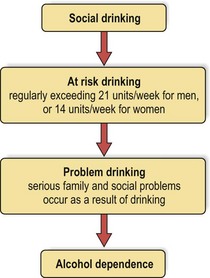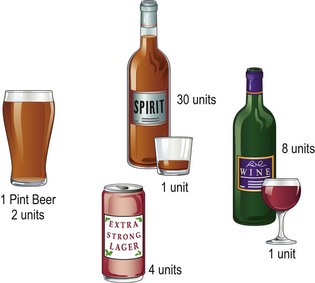Alcohol dependence I
Introduction
About 90% of the adult population drinks alcohol at some time. There is a continuum between normal social drinking, problem drinking and dependence on alcohol, and it can be difficult to distinguish between these states (Fig. 1). Maximum ‘safe’ levels of consumption have been recommended, above which the risk of sustaining some social or physical damage rises considerably. These levels are 21 units per week for men, and 14 per week for women (Fig. 2). At least 25% of men and 15% of women exceed these quantities. About one in ten of these will experience some significant difficulties in their physical or mental health, relationships, ability to work or some other aspect of their lives. Twenty percent of all admissions to psychiatric units are for alcohol-related problems.
Clinical features
 Feeling compelled to drink. There is such a strong desire to drink that alcoholics often feel they have no control over their drinking behaviour, and if alcohol is not available it is craved for. Many dependent drinkers want to stop but feel they cannot.
Feeling compelled to drink. There is such a strong desire to drink that alcoholics often feel they have no control over their drinking behaviour, and if alcohol is not available it is craved for. Many dependent drinkers want to stop but feel they cannot. Withdrawal symptoms which appear within 6 hours of the last drink. Typically this occurs overnight, resulting in withdrawal symptoms first thing in the morning. The earliest symptom to occur is usually tremor. If alcohol is not drunk quickly other symptoms follow, including anxiety, agitation, nausea, vomiting and sweating. Generalised convulsions can occur, and one in 20 will develop delirium tremens (DTs). Withdrawal symptoms can continue for up to a week if untreated.
Withdrawal symptoms which appear within 6 hours of the last drink. Typically this occurs overnight, resulting in withdrawal symptoms first thing in the morning. The earliest symptom to occur is usually tremor. If alcohol is not drunk quickly other symptoms follow, including anxiety, agitation, nausea, vomiting and sweating. Generalised convulsions can occur, and one in 20 will develop delirium tremens (DTs). Withdrawal symptoms can continue for up to a week if untreated.Stay updated, free articles. Join our Telegram channel

Full access? Get Clinical Tree






